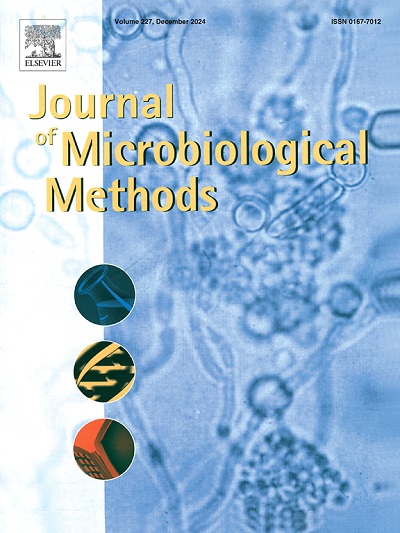评估核酸扩增系统 GENECUBE 在血液培养样本中快速检测葡萄球菌 nuc 和 mecA 的效果。
IF 1.9
4区 生物学
Q4 BIOCHEMICAL RESEARCH METHODS
引用次数: 0
摘要
研究目的本研究确定了 GENECUBE 核酸快速扩增检验是否能直接检测临床血培养样本中葡萄球菌和其他各种病原体的 nuc 和 mecA 基因:2020年9月至2021年12月期间,使用传统检测方法(MicroScan WalkAway96或VITEK 2系统)和GENECUBE nuc和mecA检测方法对192名疑似菌血症患者的537份血液培养样本进行了检测。对于常规检测和 GENECUBE 检测结果不一致的样本分离物,则使用 MALDI-TOF 质谱、头孢西丁盘扩散检测、氧西林肉汤微量稀释检测和 mecA 测序进行进一步评估。制备了含有甲氧西林敏感金黄色葡萄球菌(MSSA)和耐甲氧西林表皮葡萄球菌(MRSE)混合物的细菌溶液,以评估 mecA 的检测限(LOD):以传统检测方法为参照,GENECUBE 的灵敏度、特异性、阳性预测值和阴性预测值(95 % 置信区间)分别为 100 %(96.8-100 %)、100 %(99.1-100 %)、100 %(96.8-100%)和 100%(99.1-100%);检测 mecA 的预测值分别为 100%(96.1-100%)、98.9%(97.4-99.6%)、94.9%(88.5-98.3%)和 100%(99.2-100%)。对使用传统方法鉴定为对甲氧西林敏感的葡萄球菌和使用 GENECUBE 鉴定为耐甲氧西林的葡萄球菌的五个样本进行测序分析,结果显示所有样本中都存在耐甲氧西林的分离株。使用 GENECUBE 测定 mecA 的估计 LOD 为 104 菌落总数(CFU)/毫升 MRSE,而使用传统测定法的 LOD 为 105 CFU/毫升:结论:GENECUBE 检测法能准确检测出血培养阳性样本中的麦卡菌,其灵敏度高于传统检测法。本文章由计算机程序翻译,如有差异,请以英文原文为准。
Evaluation of a nucleic acid amplification system, GENECUBE, for rapid detection of staphylococcal nuc and mecA in blood culture samples
Objective
This study determined whether the GENECUBE rapid nucleic acid amplification test could directly detect nuc and mecA genes in clinical blood culture samples of Staphylococcus and various other pathogens.
Methods
Between September 2020 and December 2021, 537 blood culture samples from 192 patients with suspected bacteremia were tested using conventional assays (MicroScan WalkAway96 or VITEK 2 systems) and GENECUBE nuc and mecA assays. Isolates from samples with discrepant results between the conventional and GENECUBE assays were further evaluated using MALDI-TOF mass spectrometry, disk diffusion testing using cefoxitin, broth microdilution testing using oxacillin, and sequencing for mecA. Bacterial solutions containing a mixture of methicillin-susceptible Staphylococcus aureus (MSSA) and methicillin-resistant Staphylococcus epidermidis (MRSE) were prepared to evaluate the limit of detection (LOD) of mecA.
Results
Using conventional assays as the reference, the sensitivity, specificity, and positive and negative predictive values (95 % confidence interval) of GENECUBE were 100 % (96.8–100 %), 100 % (99.1–100 %), 100 % (96.8–100 %), and 100 % (99.1–100 %), respectively, for nuc detection and 100 % (96.1–100 %), 98.9 % (97.4–99.6 %), 94.9 % (88.5–98.3 %), and 100 % (99.2–100 %), respectively, for mecA detection. Sequencing analysis of five samples identified as methicillin-sensitive staphylococci using conventional assays and methicillin-resistant staphylococci using GENECUBE revealed the presence of methicillin-resistant isolates in all samples. The estimated LOD of mecA was 104 colony-forming units (CFU)/mL of MRSE with GENECUBE, compared with 105 CFU/mL with conventional assays.
Conclusion
The GENECUBE assay accurately detected mecA in positive blood culture samples and had higher sensitivity than conventional assays.
求助全文
通过发布文献求助,成功后即可免费获取论文全文。
去求助
来源期刊

Journal of microbiological methods
生物-生化研究方法
CiteScore
4.30
自引率
4.50%
发文量
151
审稿时长
29 days
期刊介绍:
The Journal of Microbiological Methods publishes scholarly and original articles, notes and review articles. These articles must include novel and/or state-of-the-art methods, or significant improvements to existing methods. Novel and innovative applications of current methods that are validated and useful will also be published. JMM strives for scholarship, innovation and excellence. This demands scientific rigour, the best available methods and technologies, correctly replicated experiments/tests, the inclusion of proper controls, calibrations, and the correct statistical analysis. The presentation of the data must support the interpretation of the method/approach.
All aspects of microbiology are covered, except virology. These include agricultural microbiology, applied and environmental microbiology, bioassays, bioinformatics, biotechnology, biochemical microbiology, clinical microbiology, diagnostics, food monitoring and quality control microbiology, microbial genetics and genomics, geomicrobiology, microbiome methods regardless of habitat, high through-put sequencing methods and analysis, microbial pathogenesis and host responses, metabolomics, metagenomics, metaproteomics, microbial ecology and diversity, microbial physiology, microbial ultra-structure, microscopic and imaging methods, molecular microbiology, mycology, novel mathematical microbiology and modelling, parasitology, plant-microbe interactions, protein markers/profiles, proteomics, pyrosequencing, public health microbiology, radioisotopes applied to microbiology, robotics applied to microbiological methods,rumen microbiology, microbiological methods for space missions and extreme environments, sampling methods and samplers, soil and sediment microbiology, transcriptomics, veterinary microbiology, sero-diagnostics and typing/identification.
 求助内容:
求助内容: 应助结果提醒方式:
应助结果提醒方式:


